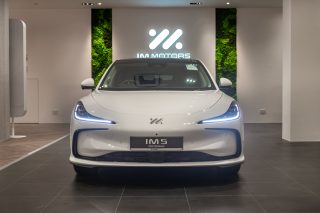
Citroen Oli.
Citroen has revealed the Oli, a pickup concept designed to deliver no-nonsense, all-electric mobility to the masses.
And what mobility indeed. The Oli is said to deliver a range of 400km, all while running on a 40kWh battery.
However, this range is also achieved by limiting the Oli’s top speed to just 110km/h.
CITROEN OLI: WEIGHT SAVING BODY PANELS
Aiding this impressive range is a long suite of innovate features.
To start, the bonnet and roof panels of the Citroen Oli are made out of recycled corrugated cardboard, so as to keep total body weight down, and total electric range high.
Coated in a layer of polyurethane resin for protection against the elements, the carboard is formed into a honeycomb sandwich structure between fibreglass reinforcing panels for the necessary strength.

Goodyear Eagle GO concept tyres here can be retreaded twice, delivering a 498,000km lifesapan.
Citroen states that the innovative construction method results panels are very rigid, light and strong – so much so that an adult can stand on them.
The total weight of the panels is also said to be reduced by 50% when compared to an equivalent steel roof construction.
SIMPLIFIED CONSTRUCTION TO KEEP COSTS LOW
The Citroen Oli also sports many design features so as to cut production costs.
The central bumper sections at the front and rear of the car, for example, are identical. The rest of the bumper sections, meanwhile, are made from 50% recycled materials and are 100% recyclable.
At the front, the Citroen Oli also utilises an upright windscreen so as to reduce the total amount of glass used.

Rear bed measures 994mm x 679mm and can be accessed via the opening rear screen.
And in order to compensate for the poor aerodynamic efficiency of this windscreen, the Oli utilises an experimental ducting system, which you can spot between the front section of the bonnet and the flat top panel.
This panel blows air towards the screen in order to create a curtain effect and smooth airflow over the roof.
Move to the side and you’ll find that the front doors of the Oli follow that of the Citroen Ami. They are identical on each side, albeit mounted differently, done to reduce manufacturing complexity and thus keep costs down.
The utilitarian doors are also said to save up to 1.7kg each, thanks to the removal of any loudspeakers, soundproofing materials and electrical wiring.
PRACTICAL ELECTRIC MOBILITY FOR ALL
And at the rear, in place of a boot, the Citroen Oli instead utilises a pick-up bed, for added practicality.
Step into the Citroen Oli and you’ll note that that the minimalist design ethos of the Ami has also been applied here.
There’s no infotainment screen available in the Oli, instead, a symmetrical beam that runs across the width of the console will offer smartphone docks, so users can stay connected and navigate all via their own phones.

No infotainment screens here: You’re expected to use your own smartphone for navigation.
This beam also houses the steering column and the toggle switches for the air conditioning system in its centre.
This design, Citroen states, allows the Oli to keep the total parts count to just 34, as compared to the total of 75 parts typically seen in a family hatchback to build the dashboard and centre console
Seating here is made up of strong tubular frames onto which are mounted a comfortable base cushion. This cushion is covered in textile made from 100% recycled polyester which is 100% recyclable.
Citroen additionally states that the Oli does not preview any specific upcoming production vehicle.
It does state, however, that many of its features will see use in the firm’s future all-electric models. We can hardly wait to see what’s in store.




















